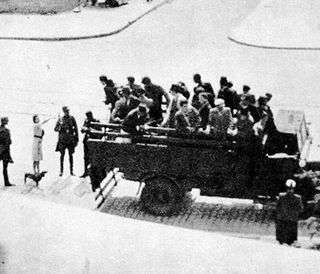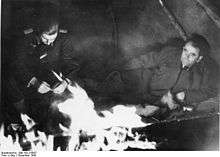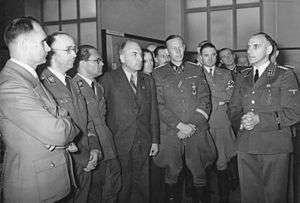Organisation Todt
| Organisation Todt (OT) | |
|---|---|
|
From left: Rudolf Hess, Heinrich Himmler, Philipp Bouhler, Fritz Todt and Reinhard Heydrich listen to Konrad Meyer at a Generalplan Ost exhibition in Berlin, 20 March 1941 | |
|
Woman with Ostarbeiter OT badge at Auschwitz | |
| Operation | |
| Period | 1933 – 1945 |
| Location | German-occupied Europe |
| Prisoners | |
| Total | 1.4 million (1944) |
| Deaths | varied according to different sources |
The Todt Organisation (German: Organisation Todt, OT) was a Third Reich civil and military engineering group in Germany named after its founder, Fritz Todt, an engineer and senior Nazi figure. The organization was responsible for a huge range of engineering projects both in pre-World War II Germany, in Germany itself and occupied territories from France to the Soviet Union during the war. It became notorious for using forced labour.
Overview
The history of the organisation falls into three phases. A pre-war period lasted from 1933 to 1938 during which Todt's primary office was that of the General Inspector of German Roadways (Generalinspektor für das deutsche Straßenwesen) and his primary responsibility, the construction of the Autobahn network. The organisation was able to draw on "conscripted" (i.e. compulsory) labour, from within Germany, through the Reich Labour Service (Reichsarbeitsdienst, RAD).
The second period lasted from 1938, when the OT group proper was founded, until February 1942, when Todt died in a plane crash. Following the invasion of Poland Todt was named the Minister for Armaments and Munitions in 1940 (Reichminister für Bewaffnung und Munition) and the projects of the OT group became almost exclusively military. The huge increase in the demand for labour created by the various military and paramilitary projects was met by a series of expansions of the laws on compulsory service, which ultimately obligated all Germans to arbitrarily determined (i.e., effectively unlimited) compulsory labour for the state: Zwangsarbeit.[1] From 1938–40, over 1.75 million Germans were conscripted into labour service. From 1940–42, Organization Todt began its reliance on Gastarbeitnehmer (guest workers), Militärinternierte (military internees), Zivilarbeiter (civilian workers), Ostarbeiter (Eastern workers) and Hilfswillige ("volunteer") POW workers.

The third period lasted from 1942 until the end of the war, when Albert Speer succeeded Todt in office and the OT was absorbed into the renamed and expanded Ministry for Armaments and War Production (Reichsministerium für Rüstung und Kriegsproduktion). Approximately 1.4 million labourers were in the service of the Organisation. Overall, 1% were Germans rejected from military service and 1.5% were concentration camp prisoners; the rest were prisoners of war and compulsory labourers from occupied countries. All were effectively treated as slaves and existed in the complete and arbitrary service of a ruthless totalitarian state. Many did not survive the work or the war.
1933–38: Autobahn construction
The Autobahn concept did not originate with the Nazis but had its beginnings in the efforts of a private consortium, the HaFraBa (Verein zur Vorbereitung der Autostraße Hansestädte-Frankfurt-Basel), founded in 1926 for the purpose of building a high-speed highway between Northern Germany and Basel, in Switzerland. With a decree establishing a Reichsautobahnen project for an entire network of highways, issued on 27 June 1933, Adolf Hitler made it a vastly more ambitious public project and that responsibility rested on Fritz Todt's shoulders as the newly named Inspector General of German Roadways.[2]
By 1934, Todt had succeeded in elevating his office to near cabinet rank. Todt was, however, also an extremely capable administrator and the organization had, by 1938, built more than 3,000 km (1,900 mi) of roadway. The Autobahn project became one of the show pieces of the Nazi regime. In that period Todt had also put together the administrative core of what would properly speaking become the Organisation Todt.
Initially, the Autobahn project relied on the open labour market as a source of workers. Germany was at this time still recovering from the effects of the Great Depression and there was no shortage of available labour. As the economy recovered and the supply of labour became a more serious issue, the OT was able to draw on conscripted (i.e., compulsory) workers, from within Germany through the Reich Labour Service (Reichsarbeitsdienst, RAD) from 1935. As per the law of 26 June 1935, all male Germans between the ages of 18 and 25 were required to perform six months of state service.[3] In this period the work was compensated, at a rate slightly greater than that of unemployment support. The working conditions of the labour force would change drastically for the worse over the course of the following ten years.[4]

1938–42: Organisation "Todt"
The OT was not given an official name until Hitler, in a rather careless manner, did so shortly after coming to power in 1933.[5] In 1938 Todt founded the Organisation Todt proper as a consortium of the administrative offices which Todt had personally set up in the course of the Autobahn project, private companies as subcontractors and the primary source of technical engineering expertise, and the Labour Service as the source of manpower. He was appointed by Hitler as plenipotentiary for Labour within the second four-year plan, undermining Göring's rule. Investment in civil engineering work was greatly reduced. Between 1939 and 1943, in contrast to the period from 1933 to 1938, less than 1,000 km (620 mi) of roadway were added to the Autobahn system. Emphasis was shifted to military efforts, the first major project being the Westwall (known in English as the Siegfried Line) built opposite the French Maginot Line and serving a similar purpose.[6] Correspondingly, Todt himself was named Reich Minister of Armaments and Munitions in 1940. In 1941 Todt and his organization were further charged with an even larger project, the construction of the Atlantic Wall, to be built on the coasts of occupied France, the Netherlands and Belgium. Included with this project were the fortification of the British Channel Islands, which were occupied by Nazi Germany from 30 June 1940 to 9 May 1945. The only camps on British soil operated by the OT were in the Channel Islands, two of these OT camps were handed over to be run by the SS from March 1943 converting them into the Alderney concentration camps.
Forced labour

The huge increase in the demand for labour created by the Westwall and many other projects was met by a series of expansions of the laws on compulsory service, which ultimately obligated all Germans to arbitrarily-determined (i.e. effectively unlimited) compulsory labour for the state: Zwangsarbeit.[7] Between 1938 and 1940, 1.75 million Germans were conscripted into labour service. Both the Organisation Todt and the Labour Service were characteristically paramilitary in hierarchy and appearance, with elaborate sets of chevrons, armbands[8] and epaulettes, and other insignia for the display and recognition of rank. Much larger numbers of Prisoners of war and other forced labourers were employed as more Germans were conscripted into the regular army.
Fritz Todt died in a plane crash on 8 February 1942, shortly after a meeting with Hitler in East Prussia. Todt had become convinced that the war on the eastern front could not be won and thought himself independent enough to say as much to Hitler. As a result, there has been some speculation that Todt's death was a covert assassination, but this has never been substantiated. Todt was succeeded as Minister of Armaments and Munitions and de facto head of the Organisation Todt by Albert Speer.
1942–45: OT under Albert Speer
Despite the death of its namesake, the OT continued to exist as an engineering organization and drew multiple further assignments. At the beginning of 1943, in addition to its continuing work on the Atlantic Wall, the organization also undertook the construction of launch platforms in northern France for the V-1 flying bomb and V-2 rocket. In the summer of that year, following the increasingly defensive course of the German war effort, the organization was further charged with the construction of air-raid shelters and the repair of bombed buildings in cities within Germany and with the construction of underground refineries and armaments factories (Project Riese).

Administratively, however, the organization was effectively incorporated into Albert Speer's Ministry of Armaments and War Production in 1943. Speer's concerns, in the context of an increasingly desperate Germany in which all production had been severely impacted by materials and manpower shortages and by Allied bombing, ranged over almost the whole of the German war-time economy. Speer managed to increase production significantly, at the cost of a vastly increased reliance on compulsory labour. This applied as well to the labour force of the OT.
By the end of the war, the compulsory state service for Germans had been reduced to six weeks of perfunctory military training and all available conscript German manpower diverted to military units and direct military support organisations. From the beginning of 1942 at the latest, their place was increasingly taken by prisoners of war and compulsory labourers from occupied countries. Foreign nationals and POWs were often, somewhat euphemistically, referred to as "foreign workers" (Fremdarbeiter). In 1943 and 1944 these were further augmented by concentration camp and other prisoners. Beginning in the autumn of 1944, between 10,000 and 20,000 half-Jews (Mischlinge) and persons related to Jews by marriage were recruited into special units.[9]
By the end of 1944, of approximately 1.4 million labourers in the service of the Organisation Todt overall, 1% were Germans rejected from military service and 1.5% were concentration camp prisoners; the rest were prisoners of war and compulsory labourers from occupied countries.
Administrative units
|
German (national) and foreign |
Intra German
|
Administrative and working ranks
|
Officer Ranks
|
NCO Ranks
Enlisted Ranks
|
Insignia
|

|
See also
- Deutsche Ausrüstungswerke (DAW) defense contractor owned and operated by the Schutzstaffel (SS)
- Forced labour under German rule during World War II
References
- ↑ Verordnung zur Sicherstellung des Kräftebedarfs für Aufgaben von besonderer staatspolitischer Bedeutung of October 15, 1938 (Notdienstverordnung), RGBl. 1938 I, Nr. 170, S. 1441–43; Verordnung zur Sicherstellung des Kräftebedarfs für Aufgaben von besonderer staatspolitischer Bedeutung of February 13, 1939, RGBl. 1939 I, Nr. 25, S. 206f.; Gesetz über Sachleistungen für Reichsaufgaben (Reichsleistungsgesetz) of September 1, 1939, RGBl. 1939 I, Nr. 166, S. 1645–54. [ RGBl = Reichsgesetzblatt, the official organ for he publication of laws.] For further background, see Die Ausweitung von Dienstpflichten im Nationalsozialismus(German), a working paper of the Forschungsprojekt Gemeinschaften, Humboldt University, Berlin, 1996–99.
- ↑ Gesetz über die Errichtung eines Unternehmens Reichsautobahnen (German). Note that “law” is the literal translation of the German term, “Gesetz”, used in the text of this (and other) laws of the period. Given, however, that by this date legislative power had already been transferred to the executive (i.e. Hitler), primarily by means of the "authorization law" of 23 March 1933 (Gesetz zur Behebung der Not von Volk und Reich), this, and all other legislation of the Third Reich, was effectively a purely executive order, i.e. a decree (Erlass).
- ↑ Reichsarbeitsdienstgesetz (German)
- ↑ For additional general background on the Autobahn project, see Walter Brummer, Zur Geschichte der Autobahn. (German)
- ↑ Showell, p.5
- ↑ One of the quasi-civil projects loosely associated with the Westwall project was the construction of the Hunsrück Highway (Hunsrückhöhenstraße, largely coinciding with the B327 and B407 in contemporary Germany). Its southern endpoint was near Trier, at the border with France and on the wall. The construction of the Hunsrück Highway forms the backdrop for the fifth chapter of Edgar Reitz' film, Heimat (1984) and one of its central figures is a (fictional) engineer on the project.
- ↑ Verordnung zur Sicherstellung des Kräftebedarfs für Aufgaben von besonderer staatspolitischer Bedeutung of October 15, 1938 (Notdienstverordnung), RGBl. 1938 I, Nr. 170, S. 1441–1443; Verordnung zur Sicherstellung des Kräftebedarfs für Aufgaben von besonderer staatspolitischer Bedeutung of February 13, 1939, RGBl. 1939 I, Nr. 25, S. 206f.; Gesetz über Sachleistungen für Reichsaufgaben (Reichsleistungsgesetz) of September 1, 1939, RGBl. 1939 I, Nr. 166, S. 1645–1654. [ RGBl = Reichsgesetzblatt, the official organ for he publication of laws.] For further background, see Die Ausweitung von Dienstpflichten im Nationalsozialismus(German), a working paper of the Forschungsprojekt Gemeinschaften, Humboldt University, Berlin, 1996–1999.
- ↑ Showell p. 6
- ↑ Gruner, Wolf (2006). Jewish Forced Labor Under the Nazis. Economic Needs and Racial Aims, 1938–1944. Institute of Contemporary History, Munich and Berlin. New York: Cambridge University Press. Published in association with the United States Holocaust Memorial Museum. ISBN 978-0-521-83875-7
Bibliography
- Showell, Jak P. Mallmann. Hitler's U-boat bases. Sutton Publishing, 2002. ISBN 0-7509-2606-6
- Herf, Jeffrey. "The Engineer as Ideologue: Reactionary Modernists in Weimar and Nazi Germany." Journal of Contemporary History (1984): 631–648. in JSTOR
- Heyl, John D. "The Construction of the Westwall, 1938: An Exemplar for National Socialist Policymaking." Central European History (1981) 14#1 pp: 63–78. online
- Kroener, Bernhard R., Rolf-Dieter Muller, and Hans Umbreit, eds. Germany and the Second World War: Volume 5: Organization and Mobilization of the German Sphere of Power. Part I: Wartime Administration, Economy, and Manpower Resources, 1939–1941 (Oxford University Press, 2000)
- Overy, Richard J. "Mobilization for Total War in Germany 1939–1941." English Historical Review (1988): 613–639. in JSTOR
- Overy, Richard J. "Cars, roads, and economic recovery in Germany, 1932–8." The Economic History Review (1975) 28#3 pp: 466–483. online
- Shand, James D. "The Reichsautobahn: Symbol for the Third Reich." Journal of Contemporary History (1984): 189–200. in JSTOR
- Taylor, Blaine. Hitler's Engineers: Fritz Todt and Albert Speer-Master Builders of the Third Reich (Casemate Publishers, 2010)
- Zeller, Thomas. Driving Germany: the landscape of the German autobahn, 1930–1970 (Berghahn Books, 2007)
External links
| Wikimedia Commons has media related to Organisation Todt. |
- Einsatz der Organisation Todt (German) (Historisches Centrum Hagen)
- Fritz Todt (German) (Deutsches Historisches Museum)
- Der Reichsarbeitsdienst (German) (Deutsches Historisches Museum)
- Organization Todt
- Monochrome wartime image
- Small-scale model of an Organisation Todt security guard, uniform as in autumn 1942 at the rear of the front in Russia

